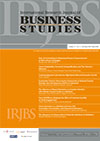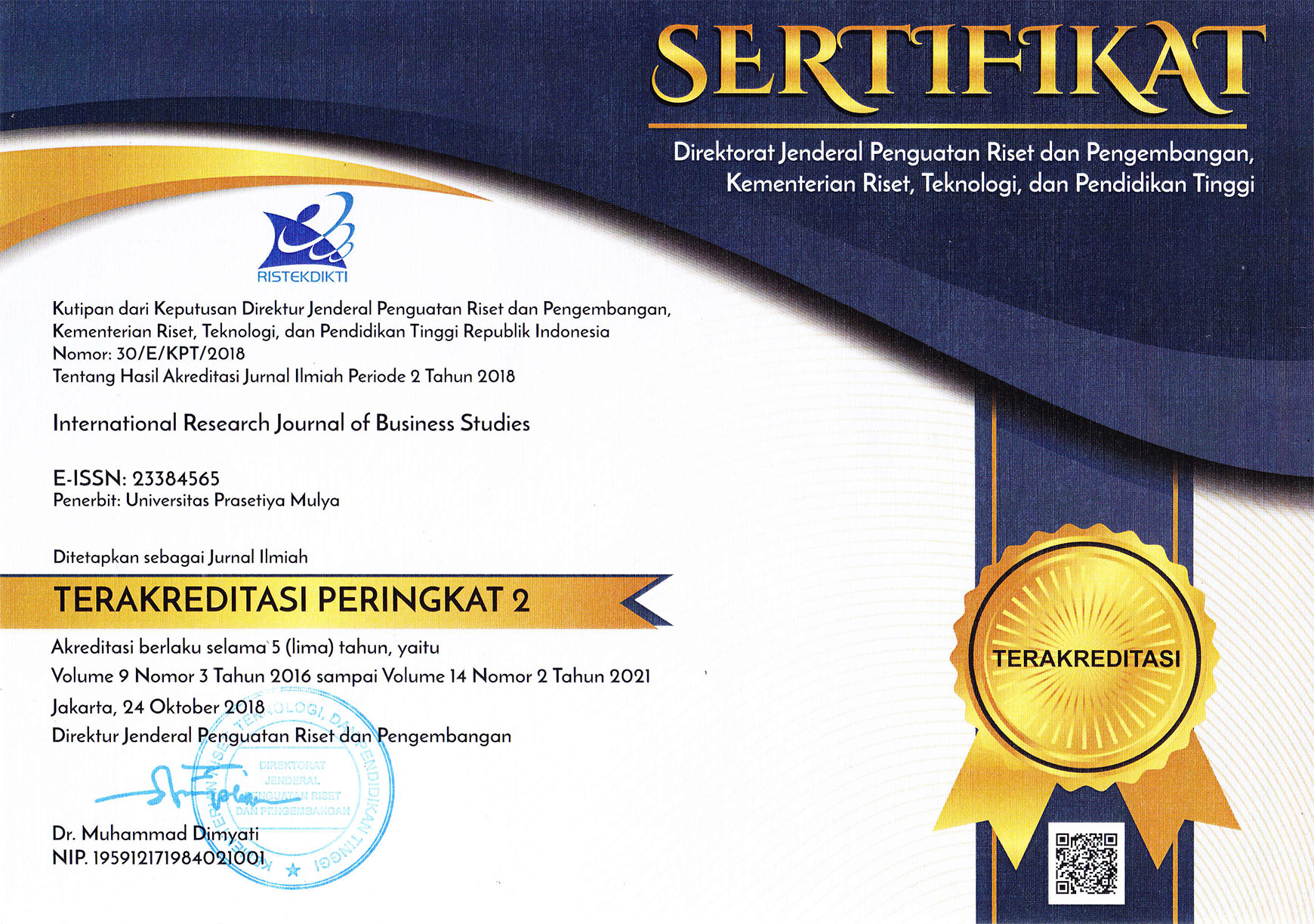The Impact of Family Control on Dividend Policy: Evidence from Indonesia
DOI:
https://doi.org/10.21632/irjbs.9.3.147-156Keywords:
family control, dividends, agency theoryAbstract
This paper examines the relationship between family control and dividend policy in Indonesia. There are three possible explanations for the relationship. The expropriation hypothesis predicts that family control has a negative impact on dividend payouts. Meanwhile the reputation hypothesis and the family income hypothesis predict that family control has a positive impact on dividend payouts. Using a panel data of Indonesian publicly listed firms in the period of 2003-2009, the results shows that family control has a significant negative impact on dividend payouts, dividend yields and likelyhood to pay dividends. The results control for other variables that may potentially affect dividend payments such as growth opportunity, debt, profitability, firm size and firm age. From agency theory perspective, the finding is consistent with the argument that family controlling shareholders prefer lower dividends, in order to preserve cash flows that they can potentially expropriate (the expropriation hypothesis).
References
Aivazian, V. & Cleary, S. (2003). Do emerging market firms follow different dividend policies from U.S. firms? Journal of Financial Research, 3, 371-387.
Anderson, R.C. & Reeb, D.M. (2003). Founding family ownership and firm performance: Evidence from the S&P 500. Journal of Finance, 58, 1301-1328.
Chen, Z, Cheung, Y.L., Stouraitis, A., & Wong, A.W.S. (2005). Ownership concentration, firm performance, and dividend policy in Hong Kong. Pacific-Basin Finance Journal, 13, 431-49.
Claessens, S., Djankov, S., & Lang, L. 2000. “The separation of ownership and control in East Asian corporation.” Journal of Financial Economics, 58, 81-112.
Easterbrook, F.H. (1984). Two agency-cost explanations of dividends. American Economic Review, 74, 650-59.
Faccio, M., Lang, L.H.P. & Young, L. (2001). Dividends and expropriation. American Economic Review, 91, 54–78.
Fama, E. and French, K.R. (2001). Disappearing dividends: Changing firm characteristics or lower propensity to pay? Journal of Financial Economics, 60, 3-43.
Gomes, A. (2000). Going Public without Governance: Managerial Reputation Effects. Journal of Finance, 55, 615-646.
Gugler, K. (2003). Corporate governance, dividend payout policy, and the interrelation between dividends, R&D, and capital investment. Journal of Banking and Finance, 27, 1297-1321.
Isakov, D. & Weisskopf, J.P. (2015). Pay-out policies in founding family firms. Journal of Corporate Finance, 33, 330–344
Jensen, M.C. (1986). Agency costs of free cash flow, corporate finance and takeover. American Economic Review, 76, 323-329.
Jensen, G., Solberg, D, & Zorn, T. (1992). Simultaneous determination of insider ownership, debt, and dividend policy. Journal of Financial and Quantitative Analysis, 27, 247-263.
Johnson, S, Boone, P, Breach, A. & Friedman, E. (2000a). Corporate governance in the Asian financial crisis. Journal of Financial Economics, 58, 141-186.
Johnson, S, La Porta, R, Lopez-de-Silanes, F. & Shleifer, A. (2000b). Tunneling. American Economic Review, 90, 22-27.
Kennedy, P. (2003). A Guide to Econometrics. Oxford: Blackwell Publishing.
La Porta, R., Lopez-de-Silanes, F., Shleifer, A., Vishny, R. (2000). Agency problems and dividend policies around the world. Journal of Finance, 55, 1-33.
Myers, S. (2000). Outside equity. Journal of Finance, 55, 1005-1037.
Pindado, J, Requejo, I, de la Torre, C. (2012). Do Family Firms Use Dividend Policy as a Governance Mechanism? Evidence from the Euro zone. Corporate Governance: An International Review, 20, 413-431.
Rozeff, M. (1982). Growth, beta, and agency costs as determinants of dividend payout ratios. Journal of Financial Research, 5, 249-259.
Schmid, T, Ampenberger, M., Kaserer, C. & Achleitner, A-K. (2010). Controlling shareholders and payout policy: Do founding families have a special “taste for dividends”?, CEFS Working Paper No. 2010-1. 2010.
Setia-Atmaja, L. (2010). Dividend and Debt Policies of Family Controlled Firms: The Impact of Board Independence. International Journal of Managerial Finance, 6, 128 - 142
Shleifer, A. and Vishny, R. (1997). A survey of corporate governance. Journal of Finance, 52, 737-783.
Silva, L.C., Goergen, M., & Renneboog, L. (2004). Dividend Policy and Corporate Governance. New York: Oxford University Press.
Villalonga, B. & Amit, R. (2006). How do family ownership, control, and management, affect firm value? Journal of Financial Economics, 80, 385-417.
Yoshikawa, T. & Rasheed, AA. (2010). Family Control and Ownership Monitoring in Family‐ Controlled Firms in Japan. Journal of Management Studies, 47, 274-295.
Downloads
Submitted
Published
How to Cite
Issue
Section
Categories
License
Copyright (c) 2016 Lukas Setia Atmaja

This work is licensed under a Creative Commons Attribution-ShareAlike 4.0 International License.
Journal Author(s) Rights
For IRJBS to publish and disseminate research articles, we need publishing rights (transferred from the author(s) to the publisher). This is determined by a publishing agreement between the Author(s) and IRJBS. This agreement deals with the transfer or license of the copyright of publishing to IRJBS, while Authors still retain significant rights to use and share their own published articles. IRJBS supports the need for authors to share, disseminate and maximize the impact of their research and these rights, in any databases.
As a journal Author, you have rights to many uses of your article, including use by your employing institute or company. These Author rights can be exercised without the need to obtain specific permission. Authors publishing in IRJBS journals have comprehensive rights to use their works for teaching and scholarly purposes without needing to seek permission, including:
- use for classroom teaching by Author or Author's institution and presentation at a meeting or conference and distributing copies to attendees;
- use for internal training by the author's company;
- distribution to colleagues for their research use;
- use in a subsequent compilation of the author's works;
- inclusion in a thesis or dissertation;
- reuse of portions or extracts from the article in other works (with full acknowledgment of the final article);
- preparation of derivative works (other than commercial purposes) (with full acknowledgment of the final article);
- voluntary posting on open websites operated by the author or the author’s institution for scholarly purposes,
(But it should follow the open access license of Creative Common CC-by-SA License).
Authors/Readers/Third Parties can copy and redistribute the material in any medium or format, as well as remix, transform, and build upon the material for any purpose, even commercially. Still, they must give appropriate credit (the name of the creator and attribution parties (authors' detail information), a copyright notice, an open access license notice, a disclaimer notice, and a link to the material), provide a link to the license, and indicate if changes were made (Publisher indicates the modification of the material (if any) and retain an indication of previous modifications.
Authors/Readers/Third Parties can read, print and download, redistribute or republish the article (e.g. display in a repository), translate the article, download for text and data mining purposes, reuse portions or extracts from the article in other works, sell or re-use for commercial purposes, remix, transform, or build upon the material, they must distribute their contributions under the same license as the original Creative Commons Attribution-ShareAlike (CC BY-SA).
This work is licensed under a Creative Commons Attribution-ShareAlike 4.0 International License.








